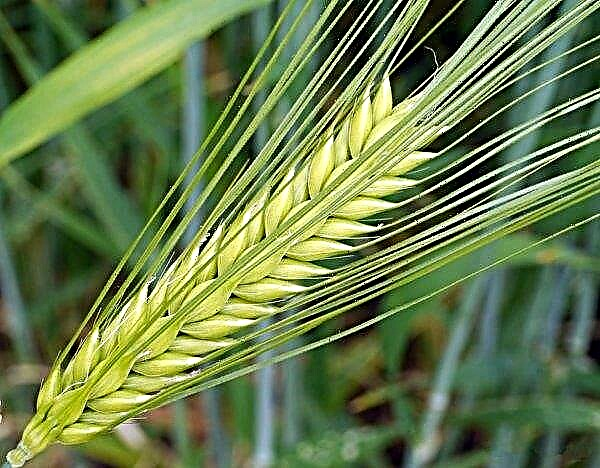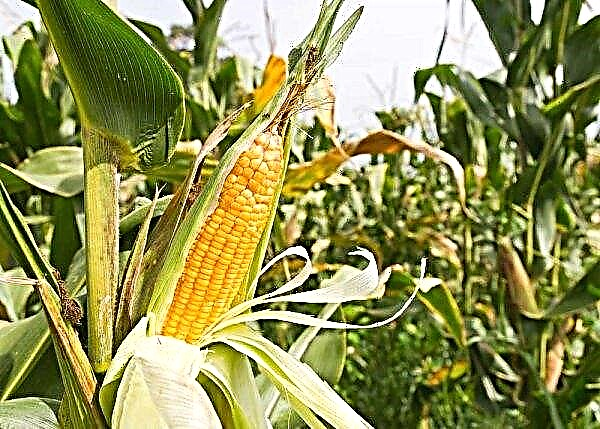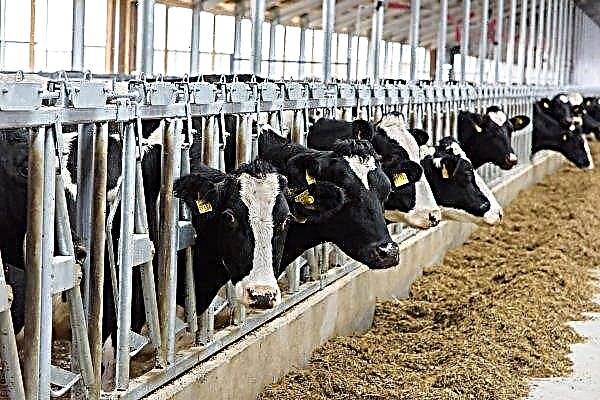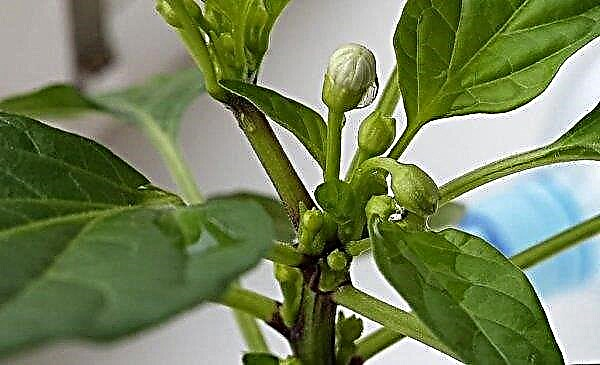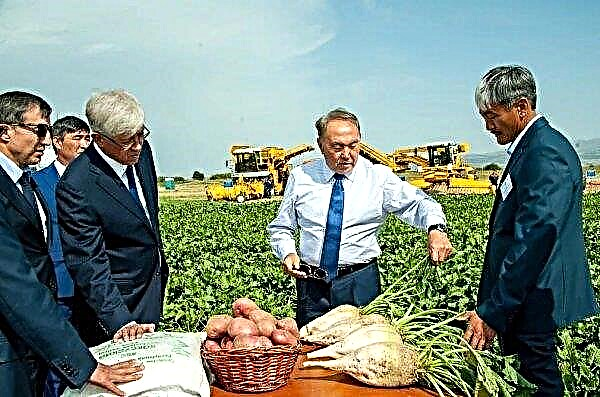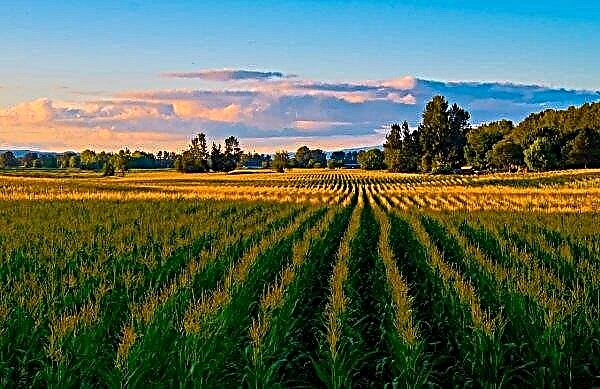Amazingly diverse forms are able to create nature both in the wild landscape and among the plants we are used to growing in our garden. In this article you will learn about the original creation of nature, the sort of melon, which received many different names. The old woman, grandmother, old maid and many other variations of the name were chosen for a reason. The history of the variety, its characteristics, cultivation method, rules for care, harvesting and storage will be discussed in this article.
History and description of the variety
Original in appearance and taste, the melon has an equally interesting selection history, and its useful qualities are completely amazing.
Selection
The historical homeland of melon is Asia. It is not known for certain which country became the ancestor of the cultivation of this crop, but it is known that melon fruits have been growing in this sunny part of the world for more than four centuries. The melon of the Kampyr variety belongs to the Uzbek branch of pumpkin, and this selection was obtained back in the Middle Ages and was named after all the female elders, because the name “Kampyr” is translated from Uzbek as “grandmother”.
Did you know? Melon contains a lot of fiber, so it is ideal for losing weight. A great alternative to high-calorie desserts.
Characteristic
In appearance, the melon of the Old Maiden variety, as it is often called, fully justifies its unusual name, because its skin, like the face of an elderly woman, is covered with deep furrows, such as wrinkles. A good comparison is the fig, with which this representative of the pumpkin family is very similar in texture. The color of the Old Maiden variety varies between different shades of yellow and green.
Near the pedicel, the fruit has a characteristic bulge, similar to a pointed hat or cone. The peel of such a representative of the pumpkin family is unusually thick and dense. The pulp is juicy and watery. The smell can be described as an adjective fresh, and the fruit tastes a little like a melon, a cucumber, a fig, and a pumpkin. In a word, a very interesting and unusual oriental delicacy. The size of such a melon does not exceed 30 cm in diameter, and the weight reaches 2-3 kg.
Chemical composition
In addition to the original appearance and interesting taste and aromatic properties, the melon of the Kampyr variety has a high content of useful macro- and microelements, and also contains many vitamin and mineral compounds.
100 g of melon contains:
- water - 88.5 g;
- proteins - 0.6 g;
- carbohydrates - 10.3 g (including mono- and disaccharides - 9 g);
- dietary fiber (fiber) - 0.6 g;
- pectins - 0.4 g;
- organic acids - 0.12 g;
- ash - 0.5 g.
From vitamin complexes, the fruits of melon contain:
- Vitamin A (beta-carotene) - 0.4 mg;
- Vitamin B1 (thiamine) - 0.04 mg;
- vitamin B2 (riboflavin) - 0.04 mg;
- viacin (vitamin B3 or vitamin PP) - 0.4 mg;
- folic acid (vitamin B9) - 6 mcg;
- Vitamin C (ascorbic acid) - 20 mg;
- Vitamin E (tocopherol) - 0.1 mg.
The composition of macronutrients include:
- potassium - 118 mg;
- calcium - 16 mg;
- magnesium - 13 mg;
- sodium - 32 mg;
- phosphorus - 12 mg.
And among trace elements distinguish:
- iron - 1.0 mg;
- iodine - 2 mcg;
- cobalt - 2 mcg;
- Manganese - 35 mcg;
- copper - 47 mcg;
- fluorine - 20 mcg;
- zinc - 90 mcg.
About 38-42 kcal per 100 g of product, depending on the degree of maturity of the fetus.
Benefit and harm
Due to such a diverse and rich content of useful minerals and vitamins, the fruits of melon culture are considered very useful. Melons varieties Starushka were no exception.
- Among their useful properties include:
- general strengthening of immunity;
- blood cell regeneration;
- balancing hemoglobin levels;
- beneficial effects on the heart and cardiovascular system;
- obstruction of blood clots;
- gastrointestinal cleansing;
- normalization of the intestines;
- flushing the kidneys, adrenal glands and the entire urinary system;
- prevention of kidney stones;
- balancing the intestinal microflora;
- an increase in the action of antibiotics in various diseases and a decrease in their toxicity;
- beneficial effects on the nervous system and brain.
Important! People suffering from diabetes are not recommended to eat melon fruit because of the high amount of simple carbohydrates that can affect the patient's condition. Therefore, before consuming melon, you should consult your doctor and determine an acceptable norm, if possible with the existing stage of diabetes.
Melon is not capable of causing harm. The main thing to consider is to adhere to the norm and not overeat.
- If you eat more than one melon fruit per day, it can contribute to:
- thinning the stool;
- bloating;
- increased gas generation due to fermentation processes during digestion.
You should also be careful in case of individual intolerance or allergic reactions.

Advantages and disadvantages
- The indisputable advantages of melons varieties Grandmother is:
- an abundant spectrum of positive effects on the human body. This is a real storehouse of utilities that can rarely be found in any other product;
- the cultivation of such a melon is not a time-consuming or technologically difficult undertaking, and therefore not only the farmer, but also a simple summer resident or the owner of his own garden can cope with it.
- Of the shortcomings of the grandmother melon can be identified:
- a very specific taste, which differs from the well-known melon;
- its low rate of keeping quality. This variety is not able to maintain its shape for a long time and quickly begins to soften, fade and rot.
How to grow yourself in the garden
Growing gourds on your site is a fairly simple and not time-consuming task that any gardener can handle. And to make this process perfect, let's take a closer look at the rules and recommendations for growing melons.
Did you know? Melon is a symbol of fertility and life, as well as luxury, since in the past these fruits were in short supply and were expensive.
The timing
Planting melon in the soil is not recommended before the end of April and beginning of May, due to the fact that the soil and air temperature are still not warm enough. Even if the temperature has been quite high lately, there is still a risk of nightly cold weather, and the soil needs at least 7-10 days of constant and stable high temperature for proper heating. The optimal temperature regime for melons varies from +18 ... + 20 ° С to +26 ... + 28 ° С.

Seat selection and crop rotation
The best place for planting gourds is open areas, mainly on the southern slopes or simply accessible to sunlight. It is the abundance of the sun that is the key factor in the success of melon cultivation. Thanks to warming, melons are less likely to be affected by diseases, more resistant to pests, not prone to decay or mold and fungal diseases.
Soil should have a minimum level of acid balance. You can verify this very simply by inspecting the site for weeds. If wheatgrass, chamomile, knotweed, dandelions, sea grass and a number of other plants grow on the plot, then this plot is suitable in terms of pH balance.
Good precursors for this type of melon are:
- potatoes;
- bow;
- beet;
- cabbage;
- Beans
- cereals.
The following are considered neutral:Important! Before planting, it is still recommended to prevent the increased acidity of the soil by sprinkling the sides and bottom of the hole with wood ash. This will help protect the seeds from excessive acidity and a number of pests.
- Tomatoes
- cucumbers
- corn;
- greenery;
- zucchini.
It is not recommended that Bahchu plant two years in a row in the same place. Crop rotation rules must be followed to get a good and healthy crop.
Sowing pattern and depth
Melons should be planted to a depth of several strokes of the chopper. Expressing the indicator in centimeters, about 8-12 cm. With good sun and a favorable temperature, the first shoots will appear after one week. Between the rows should be left at least 75-80 cm, and it is better, if the site allows, to bring this figure to 90-100 cm, so that the plant has room to develop.
How to care in the open ground
Special attention should be paid to the rules and recommendations for ensuring proper care of the melon plantation.
Temporary shelter
Under temporary shelter is meant a cardboard or special plastic fence around the perimeter of the hole, which is used to protect seedlings from wind, cold dew, fog, ground pests. Such shelter allows you to save seedlings and minimize losses at this stage. From above, the plants are open and continue to receive a sufficient amount of light and heat from the sun, as well as moisture, in case of rainfall.
Such a shelter can be purchased at a gardening store or made independently. The available material can be empty 10-liter water cylinders (about 5 can be made from one), cardboard from under the boxes for packing household appliances can also be used, although it is better to wrap it with cling film or foil to protect it from moisture and natural destruction . Such protection can be removed when the seedlings begin to spread along the ground, that is, closer to the end of May and the beginning of June.
Important! During the installation of a temporary shelter, monitor the condition of the plants. If you notice yellowing or wilting, it is better to remove the shelter, because it, in addition to protecting against various undesirable factors, also interferes with the ventilation and natural “breathing” of the young shoot, which can lead to disruption of the natural vegetation cycle.
Watering
Watering measures are best carried out using an irrigation system when several sprinklers are installed on the plantation and water is supplied through the hoses. Such a system of sprinklers will create the most natural conditions for precipitation, which will help seedlings grow and grow faster. You can also use drip irrigation, but with a similar system you will have to tinker more at the construction stage, as well as spend a lot more money on its purchase and assembly.
As for water, you can use water from a source (well, well, river) or rainwater. It is also possible to use the water deferred in barrels, previously drawn there and left for 24 hours. Reserved water, as well as rainwater, will have a number of advantages, because they will not have heavy salts, alkalis or metal impurities, often found in springs and natural reservoirs.
The frequency of irrigation is regulated by natural conditions, climate and aridity of the season. In case of heat and drought, it is recommended to water at least 1-2 times a week. In other cases, once a week will be enough. Monitor the condition of the land and plants and adjust the irrigation regime in accordance with the results of observations.
Top dressing
In the spring, plants need growth and development catalysts, which are nitrogen-containing fertilizers. One such feeding a month will be enough to grow a rich and environmentally friendly melon crop. If you overdo it with nitrates, then the fruits will not have the previously described utility, and the taste can be completely unacceptable.
In addition to nitrogen, melons may also require phosphate and potassium fertilizers, which are also applied no more than once a month. The first top dressing can begin already in the second week from the moment of planting seeds in the ground. Further fertilizer should be applied as necessary until the end of the season.
Bushes
The formation of the bushes of the grandmother's melon is done in order to remove weak shoots, which only take away the power from the plant, thereby depriving the life-giving juices of the fruit. Initially, it is recommended to leave no more than five healthy and strong shoots on one bush.
All the rest should be removed with a clean and sharp knife, carefully cutting them at the very place of docking with the stem. Weak processes are visible by the thickness of the stem and the color and size of the foliage. The stem is thinner than the rest, and the leaves are smaller and not so saturated green. Also, on weak processes, fruit-bearing flowers are completely absent. Such a process should be removed.
Did you know? The ancient Egyptians grew melon another 2000 years BC. e.
Soil care
Weed weeding should be another cornerstone in the cultivation of gourds. At the initial stage, weeding and loosening of the soil will have to be done after each irrigation or rain, so that on the surface of the earth a baked crust does not form that can injure the young shoot. The stronger the bush grows, the less often it will have to produce loosening, again in order to protect the shoots. At an early stage, cultivation is also recommended to mulch in order to save as much moisture as possible and protect the soil from the scorching rays of the sun.

Harvesting and storage
Melon variety Granny matures closer to autumn. This is a late variety, and therefore it will take a long time to wait for the harvest. The ripeness of the fetus is determined through the achievement of a tan skin tone. Another way to determine ripeness is a dry tail (it is located between the peduncle and the marginal leaf).
According to the shelf life, this variety does not have a long shelf life. Already in the third month from the date of harvest, the melons begin to deteriorate, and therefore it is important to store them correctly in order to maximize the shelf life. To do this, it is recommended to suspend the fruits of gourds in food nets one at a time, in order to exclude any contact with hard surfaces, due to which the process of decay begins.
An alternative storage method will be sand or hay, which will serve as a kind of pillow for preservation. But it’s better to eat melon as quickly as possible or process it for jam, jam, jam or other preservation.
Guided by the recommendations given in this article on the cultivation, care and storage of Kampyr melon, you can successfully plant melon and harvest a plentiful crop.


